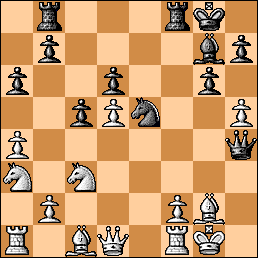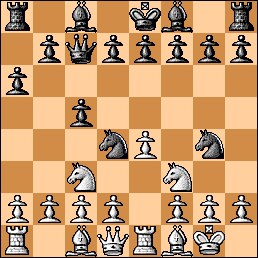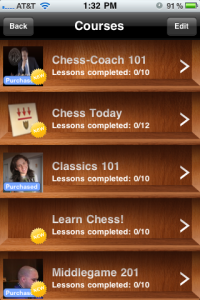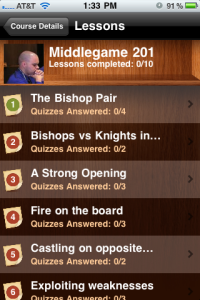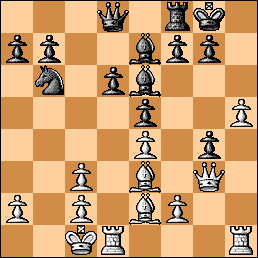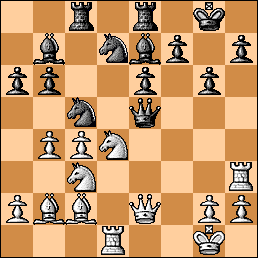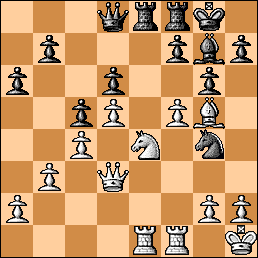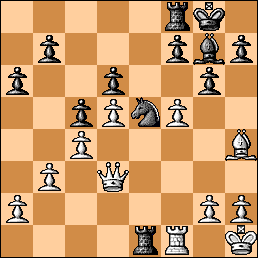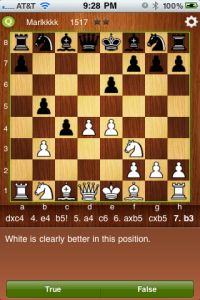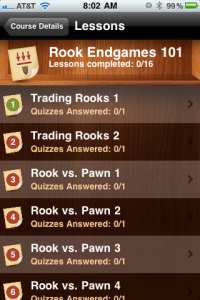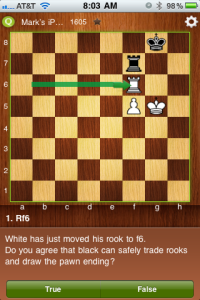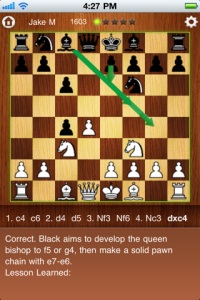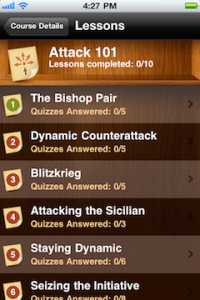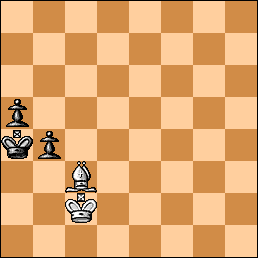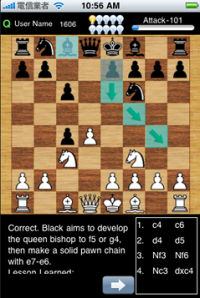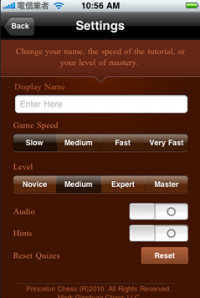I just received a news communique about the first-ever U of Arizona – ASU chess match! This was a face-to-face match at ASU (not online). And as you can see, it was a close one. The U of Arizona Wildcats prevailed, much like their basketball team got further in the NCAA’s. Nevertheless the Sun Devils pulled off some victories in the 6-board G/60 match.
The Sun Devil Heartbreak
“Dear Chess Fans,
Arizona State University invited University of Arizona to a chess match that coincided with the Master Trek tournament on April 23, 2011. As far as I know, this is the first time ASU and U of A have ever played each other in a team match.
The time control was set at G/60. U of A beat ASU 3.5 – 2.5, but given the players were closely matched and given the topsy-turvy nature of the games, no one could foresee the result until the final seconds (when I blew a won position against Ben Marmont).
Attached are all 6 games along with my annotations and variations. I invited everyone from both teams to comment as well, but received no responses. Please feel free to post and comment on the games and annotations how you see fit.
Sincerely,
Expert Jeff Green
President, Chess Club @ ASU”
From the ASU President Emeritus
This school year has been the first in a decade that ASU has organized a competitive chess team. Since the Pan-American Intercollegiate Championship is held over winter break, I needed something to spark the interest of the team in the “off-season.” The University of Arizona is not only our school’s rival, but also fields a formidable chess team, headed by FM Warren Harper and Experts Amanda Mateer and Ben Marmont. The gauntlet was thrown down and we agreed to meet on April 23rd at IM Danny Rensch’s Master Trek tournament on the ASU campus. Despite having the home board advantage, we lost a very close match to the Wildcats (3.5-2.5).
The time control was 55 minutes with a 5 second delay, and the match was a six board, single game match. On board one FM Saeed Mohammad played FM Warren Harper. Both of these guys have taken a bit of a break from chess to focus on school, so it was interesting to see how prepared they were. I believe that Saeed did a bit of pre-game preparation, which appeared to pay off, this match went in our favor 1-0. On board two Expert Amanda Mateer played Expert Andrew Widener. This game was the second to last to finish and ended in a drawn endgame, 1/2-1/2. On board three Expert Jeff Green played Expert Ben Marmont. This was the last game to finish, and was a heartbreak for the Sun Devils. Jeff, in time trouble, blew a won game against his former high school teammate, 0-1. The fourth board saw the match up of Ray Tan and Dean Cullen. Ray has improved very much in the last year, and will probably be an Expert soon. Dean is also a member of the Hayden Library staff and the club advisor. Ray won this match, 1-0. On board five the match up was myself, Jeff Semmens, and Matthew Noble. At the time of this game, I was the President of the Chess Club @ ASU, and I wasn’t expecting to play, but we had two no-shows, and I had to jump in at the last minute. Despite being a 140 point underdog, I pulled off the upset and earned the point for my team, 1-0. On the last board Rex Tan, brother of Ray Tan faced off against Aaron Beavor, another last minute replacement. I played on the same high school team as Rex, and I can attest that he is a better chess player than his rating suggests. Despite being slightly lower rated, Rex won the game, 1-0.
All the games were closely contested, and despite losing, all of us felt good about getting to play the match. We look forward to a rematch with the Wildcats next year, especially since we will be adding NM Nick Thompson to our team. We intend on bringing the “Territorial Cup of Chess” to Tempe in 2012.
Jeff Semmens
President Emeritus — Chess Club @ ASU
Ivy League Digression
The Games
[Event “5th Board”]
[Site “Tempe, AZ”]
[Date “2011.04.23”]
[Round “?”]
[White “Semmens, Jeff”]
[Black “Noble, Matt”]
[Result “1-0”]
[ECO “E12”]
[WhiteElo “1785”]
[BlackElo “1886”]
[Annotator “Green,Jeff”]
[PlyCount “83”]
[EventDate “2011.04.23”]
[WhiteTeam “ASU”]
[BlackTeam “U of A”]
1. d4 e6 {Tempting white to enter a French game with 2. e4. Matt seems to
prefer that opening. -JG} 2. c4 Nf6 3. Nf3 b6 4. Bg5 {White should keep his
bishop on c1 and later free it with e4. In similar structures, black gives up
the dark bishop and puts his pawns on the dark squares. Because of Bg5, black
is able to play for the same plan but without giving up the bishop pair. -JG}
{MG: 4. Bg5 is OK (well, usually Nb1-c3 and then Bc1-g5) and has been seen lots of times. There is a certain appeal to getting out first and then establishing a pawn chain behind it
with e2-e3. }
Bb7 5. e3 Be7 6. Nc3 h6 7. Bh4 Ne4
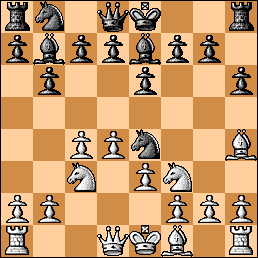
Decision Time
8. Bxe7
{ MG: Not testing. Here, strangely enough, 8. Bg3!? is very interesting. If black wants to take on g3, white can operate on the h-file. The text move leaves black near-equality.}
Qxe7 9. Nxe4 Bxe4 10. a3 d6 11. Bd3
Bb7 {MG: just taking on d3 is OK }
12. O-O Nd7 13. Re1?! {If the point of this move was to prepare e4, he
should have played it right away. -JG} g5!? {Initiating the attack
immediately. Black should probably castle kingside and worry about getting a
presence in the center first. -JG} 14. e4 e5?! {?} {Allowing white to barracade
black’s bishop.} (14… g4 $142 15. Nd2 Qf6 {Going for piece activity. -JG})
{MG: just 14…g4 15. Nd2 h5 to gain space. The text leaves a horrible hole on f5 and white can get there with the knight going from Nd2 to f1 to e3.}
15. d5 $16 g4 16. Nd2 h5 17. Nf1?! {White was better off going for b4 and c5.
It is not clear that the knight belongs here. -JG} {MG : this move is OK. White has both the pawn advances and the knight regrouping, he can do them in any order. }
Bc8?! {A bit premature.
The bishop will probably go there anyway, but at this point all of black’s
pieces are inactive and discoordinated. -JG} {MG : black has to cover f5 but it’s a bad position. }
18. Qa4 {I feel that this queen
is misplaced here. The idea is to invade c6, but even here it has less scope
than it did on d1, and it will have difficulty influencing the kingside later.}
{ MG: 18. b4! will pry open lines quickly. }
Kd8 $5 {Curious and strangely logical. I doubt if it is best though. -JG} 19.
b4 h4 20. Ne3 Nf6 21. Nf5 $6 {Black immediately gets rid of his inactive
bishop for the hyperactive knight, and he loosens white’s grip on the center
at the same time. c5 will be a little harder to play now that d5 is less
secure. -JG}
{MG: Leave the knight on e3. It’s good there. 21. c5! opening lines quickly to the black king. }
Bxf5 22. exf5 g3 23. fxg3 hxg3 24. h3 Ng4 25. Qd1 (25. Qb3 {Does
the same thing white does in the game, but in 1 less move. -JG} Nf2 26. Bf1 Qh4
{-JG}) (25. c5 bxc5 26. bxc5 {/\Qxg4} Nf2 27. Qc6 Rc8 (27… Rb8 28. Rab1) 28.
Bb5 {/\f6} f6 29. Ba6 {-Fritz})
25… Nf2 26. Qf3 Qh4 27. Re3? Qd4 -+ (27…Nxd3 28. Rxd3 e4 -+ {-Fritz} MG – indeed, that just ends the game.)
28. Ra2 Nxd3 29. Rd2 Qa1+? ‘unclear’ (29… e4 {-JS})
{MG: 29…e4! is a nice move to completely clarify the situation and give black an easy win. It liberates the forever square e5 for the black knight. }
30. Rd1 Qxa3 31. Rexd3 Qxb4 32. Qxg3 Qxc4 (32… Kd7 33. Qg7 Raf8 {‘black is better’ – White
has trouble breaking through on either side. -JG})
{MG: in fast time controls, playing for the attack even at the cost of a pawn is always good. 32..Kc8! 33. Qg7 Kb7 34. Qxf7 and now black has his choice of juicy continuations to use his connected rooks and the c5-g1 diagonal with a safe king.}
33. Qg7 (33. Rc3 Qa4 34.
Rdc1 {-JG}) 33… Qh4 34. Qxf7 $16 Qh7 35. Qf6+ Kc8 36. Qe6+ Qd7? {Kb7 is
necessary to get the other rook into action and to get the king safe. -JG} 37.
f6 Rh6 38. Rf1 c6 39. Rg3 (39. f7 $18 Rxe6 40. dxe6 {-JG}) 39… Kc7 40. Rg7
Rxf6 41. Rxd7+ Kc8 42. Qe8# 1-0
[Event “3rd Board”]
[Site “Tempe, AZ”]
[Date “2011.04.23”]
[Round “?”]
[White “Green, Jeff”]
[Black “Marmont, Ben”]
[Result “0-1”]
[ECO “A37”]
[WhiteElo “2013”]
[BlackElo “2146”]
[Annotator “Green,Jeff”]
[PlyCount “70”]
[EventDate “2011.04.23”]
[WhiteTeam “ASU”]
[BlackTeam “U of A”]
1. Nf3 c5 2. g3 Nc6 3. Bg2 g6 4. O-O Bg7 5. c4 e5 6. Nc3 Nge7 7. d3 O-O 8. a3
d6 9. Rb1 a5 10. Ne1 Be6 11. Nd5 {Played to prevent black’s d5. -JG} h6 12.
Nc2 a4 13. b4 axb3 14. Rxb3 Rb8 15. Bd2 Nd4 {Black took an awful lot of time
on this move, and I don’t think it’s a good one. Times are now approximately
40 minutes (white) to 20 minutes. -JG} 16. Nxd4 exd4 17. Qc1 {A tempo move to
allow the queen to go to b2 instead of b1. -JG} Kh7 18. Nf4 Bc8 19. Qb2 g5 20.
Nh5 {Heading into complexity with my time advantage.} (20. Nd5 Nc6 21. Nb6 Be6
22. Na4 Qc7 23. Rb1 Bc8 {Each move has the idea of taking the B-pawn, but I
saw no clear way to break through here. -JG}) 20… Bh8 21. Bxb7 Rxb7 $1 {-JG}
22. Rxb7 Bg4 23. Qb5 (23. Nf4 gxf4 24. Bxf4 Ng6 {Hitting the E-pawn and the
bishop. -JG}) 23… Bxh5 24. Rd7 Qe8 25. e3 Be2 $2 {For the idea–the point
was to win a slew of pawns, but it just loses material. -JG} 26. Re1 Bxd3 27.
exd4 Bxc4 28. Qb1+ Kg8 29. Rexe7 Qa8 30. Rxd6 Qxa3 {Now both of us are in
serious time pressure–a minute or so per side. -JG} 31. Qg6+ $2 {I
triumphantly placed the queen there thinking it was forced checkmate for some
reason. Then my opponent casually plays… -JG} (31. dxc5 Qxc5 32. Bb4 $18 {
-JG}) 31… Bg7 (31… fxg6 32. Rxg6+ Bg7 33. Rgxg7+ Kh8 34. Rh7+ Kg8 35. Reg7#
{-JG}) 32. Qc2 cxd4 33. Rdd7 Bd5 $1 {-JG} 34. Ra7 $4 {-JG} Qf3 35. Kf1 d3 {
White resigns.} 0-1
[Event “1st Board”]
[Site “Tempe, AZ”]
[Date “2011.04.23”]
[Round “?”]
[White “Mohammed, FM Saeed”]
[Black “Harper, FM Warren”]
[Result “1-0”]
[ECO “D91”]
[WhiteElo “2343”]
[BlackElo “2422”]
[Annotator “Green,Jeff”]
[PlyCount “60”]
[EventDate “2011.04.23”]
[WhiteTeam “ASU”]
[BlackTeam “U of A”]
1. d4 Nf6 2. c4 g6 3. Nc3 d5 4. Nf3 Bg7 5. Bg5
{ MG: this is the line that anti-Gruenfeld specialists such as Wang Yue use as surprise weapons, for example
Wang Yue-Svidler Baku 2008. Except Wang Yue did Bg5 one move earlier:
1. d4 Nf6 2. c4 g6 3. Nc3 d5 4. Bg5 Ne4 5. Bh4 Nxc3 6. bxc3 dxc4 7. Qa4+ Qd7 8. Qxc4 b6 9. Bg3 Nc6 10. Nf3 Bg7 11. e3 O-O 12. Be2 Bb7 13. O-O Na5 14. Qb4 Rac8 15. Ne5 Qd6 16. Rfd1 Rfd8 17. Qa4 c5 18. e4 Bxe5 19. Bxe5 Qc6 20. Qxc6 Nxc6 21. Bg4 Ra8 22. Bc7 cxd4 23. Bxd8 Rxd8 24. Be2 e5 25. Rac1 Kf8 26. f3 a6 27. Kf2 Ke7 28. Bc4 Rd7 29. Bd5 dxc3 30. Bxc6 Rxd1 31. Rxd1 Bxc6 32. Rc1 Bd7 33. Rxc3 Kd6 34. Rd3+ Kc6 35. g4 Be6 36. a3 g5 37. Ke3 Kc7 38. Rd1 b5 39. h4 h6 40. Rh1 Kd6 41. hxg5 hxg5 42. Rh5 f6 43. Rh6 Ke7 44. Rh7+ Bf7 45. Rh8 a5 46. Ra8 a4 47. Ra7+ Ke8 48. Rc7 1-0
A very convincing victory over Svidler; black’s dynamic play never materialized. }
Ne4 6. Bh4 Nxc3 7. bxc3 c5 8. e3
Nc6 9. Be2 dxc4 10. Bxc4 O-O (10… cxd4 11. cxd4 Qa5+ 12. Qd2 O-O 13. Qxa5
Nxa5 14. Bd3 e6 15. Bg3 Bd7 16. Bc7 Nc4 17. Bxc4 Rfc8 18. Be5 {Theoretical
line.}) 11. O-O Bf5 12. Re1 Rc8 13. Rc1 Be4 14. Ng5 Bd5 15. Bxd5 Qxd5 16. c4
Qd7 17. d5 Nb4 18. a3 Na2 19. Rc2 Nc3 20. Qd3 Na4 21. e4 e5 22. f4 h6 23. Nf3
exf4 24. e5 Rfe8 25. Rce2 g5 26. Bxg5 $5 (26. Bf2 a6 27. e6 fxe6 28. Ne5 Qd8
29. Qh3 Nb6 30. dxe6 $16 {-JG}) 26… hxg5 27. Nxg5 Qg4 28. Qh7+ Kf8 29. h4 Nc3
30. Rf2 Nd1 {Time pressure must have set in, as the notation is incomplete
here. White won this game.} 1-0
[Event “6th Board”]
[Site “Tempe, AZ”]
[Date “2011.04.23”]
[Round “?”]
[White “Tan, Rex”]
[Black “Beavor, Aaron”]
[Result “1-0”]
[ECO “B78”]
[WhiteElo “1546”]
[BlackElo “1638”]
[Annotator “Green,Jeff”]
[PlyCount “81”]
[EventDate “2011.04.23”]
[WhiteTeam “U of A”]
[BlackTeam “ASU”]
1. e4 c5 2. Nf3 d6 3. d4 cxd4 4. Nxd4 Nf6 5. Nc3 g6 6. Bc4
{ MG To get to a Yugoslav attack, White almost always plays 6. Be3 here; maybe there is something wrong with this move order. }
Bg7 7. f3 O-O 8. Be3
Nc6 9. Bb3 Bd7 10. Qd2 a6
{ MG: This is too slow. Black usually clears the knight from c6 then sacks a pawn with b7-b5 to clear lines quickly.}
(10… Qa5 {While white cannot chase it with Nb3. -JG
} 11. O-O-O Rfc8 12. Kb1 Ne5 13. g4 Nc4 14. Bxc4 Rxc4 15. h4 Rac8 {A book line.
Shows improvement for black over what actually occurred in the game. -JG}) 11.
O-O-O Rc8 12. g4 Ne5 (12… Na5 $142 13. h4 h5 14. gxh5 Nxh5 15. Bh6 Nxb3+ 16.
Nxb3 (16. cxb3 e5 17. Nde2 Qf6 18. Bxg7 Kxg7 19. Qxd6 (19. Kb1 Rc6 20. Rdf1
Rfc8 21. f4 Bg4 22. fxe5 Qxe5 $11 {-JG}) 19… Rfd8 20. Qxf6+ Kxf6 $11 {Black
is holding due to white’s inability to create a passer on the queenside and
the fact that black has activity on both sides of the board. -JG}) (16. axb3
Qa5 17. Kb1 Rfd8 18. Rhg1 (18. Bxg7 Kxg7 19. f4 (19. Rhg1 Rh8 20. Rg5 Rc5 21.
Rxc5 Qxc5 $13 {-JG}) 19… e5 20. Nf3 (20. f5 exd4 21. Qxd4+ Qe5 $19 {-JG})
20… Nxf4 $11 {-JG}) 18… Bh8 $11 {-JG}) 16… Bxc3 17. bxc3 Re8 {Black is
holding with some winning chances. -JG}) 13. h4 Nc4 (13… h5 14. gxh5 Nxh5 15.
Bh6 Qa5 16. Bxg7 Kxg7 17. f4 Nc4 18. Bxc4 Rxc4 19. f5 Qe5) 14. Bxc4 Rxc4 15. h5
Qc7 16. hxg6 fxg6 17. Bh6 $6 (17. g5 Nh5 (17… Ne8 18. Nd5 Qd8 19. Qh2 $18 {
-JG}) 18. Nd5 Qd8 19. Nf5 $16 {-JG}) 17… Nxe4 $1 18. Nxe4 Rxd4 19. Qh2 Rxd1+
20. Kxd1 Rf7 (20… Bxh6 21. Qxh6 Rf7 22. Ng5 Rg7 23. Nxh7 Qc4 24. Ng5 Kf8 $11
{The queen on c4 protects Rg8 while the king escapes. -JG and AB}) 21. Ng5 Qc5
$2 {-JG} (21… Qc4 22. Nxf7 Qxf7 23. Bxg7 Qxg7 {Reaching the same position,
but with the king more exposed. Still white has an advantage. -JG}) (21…
Be5 {Playing off the fact that white’s pieces interfere with each other. f4
is unplayable due to Bxg4. -JG} 22. Qh3 Qc4 23. Nxf7 Qxf7 $11 {-JG}) 22. Nxf7
Qd5+ 23. Kc1 Qxf7 24. Bxg7 Qxg7 25. Qe2 Qf7 26. Re1 Qf4+ $6 27. Qe3 Qxe3+ $2
$18 {Black’s one hope to hold a draw is piece activity. He cannot afford
exchanges. White wraps up the game cleanly after this move. -JG} 28. Rxe3 Kf7
29. g5 $1 {Excellent technique. This pawn becomes the keystone of white’s
victory. -JG} e5 30. f4 Ke6 31. fxe5 dxe5 32. Rf3 e4 33. Rf6+ Ke5 34. Kd2 Bc6
35. Ke3 Bd5 36. b3 Be6 37. c4 h6 38. Rxg6 hxg5 39. Rxg5+ Kf6 40. Rh5 Bf5 41.
Rh8 {Black resigns.} 1-0
[Event “2nd Board”]
[Site “Tempe, AZ”]
[Date “2011.04.23”]
[Round “?”]
[White “Mateer, Amanda”]
[Black “Widener, Andrew”]
[Result “1/2-1/2”]
[ECO “E99”]
[WhiteElo “2133”]
[BlackElo “2098”]
[Annotator “Green,Jeff”]
[PlyCount “68”]
[EventDate “2011.04.23”]
[WhiteTeam “U of A”]
[BlackTeam “ASU”]
1. d4 Nf6 2. c4 g6 3. Nc3 Bg7 4. e4 d6 5. Nf3 O-O 6. Be2 e5 7. O-O Nc6 8. d5
Ne7 9. Ne1
{ MG: there’s something to be said for 9. Nd2 coming to c4 later (after c4-c5).
White’s play develops quite naturally. Play over Beliavsky-Nakamura, a tour de force for white until he
blundered in the middle game and lost! I analyzed that game elsewhere on this site. Granted,
9. Ne1 is a main line but the 9. Nd2 positions have white going faster on the queenside. }
Ne8 10. Nd3 f5 11. Bd2 Nf6 12. f3 f4 13. Rc1 g5 14. c5 Ng6 15. Nb5
$5 Rf7 (15… a6 {Kicking the knight is more correct. It defeats the threat
and makes white use up a tempo. -JG}
{ MG: in these lines, on …a6 the knight often reroutes b5-a3-c4 and then pops into b6.
If it can eliminate black’s queen bishop, black has no attack. }
16. cxd6 (16. Na3 g4 17. cxd6 cxd6 18. Nc4
g3 19. Ba5 gxh2+ 20. Kxh2 Qe7 21. Rh1 Nh5 22. Nb6 Ng3 $13) 16… axb5 17. dxc7
Qd7 18. Bb4 Ne8 19. Bxf8 Bxf8 $44 {Black’s pieces are a bit muddled, but he
doesn’t have much difficulty repositioning them.}) 16. Ba5 b6 17. cxb6 (17.
cxd6 $142 cxd6 18. Bb4 Bf8 $13 {-JG}) 17… axb6 18. Be1 g4 19. Qc2 Ba6 (19…
gxf3 20. Bxf3 Ng4 21. Nxc7 Ne3 22. Qc3 Rxa2 $13 {-JG}) 20. Nb4 (20. Nxc7 Bxd3
21. Bxd3 Rc8 22. Ne6 Rxc2 23. Nxd8 Rxc1 24. Nxf7 Kxf7 $19 {-JG}) 20… Bxb5 21.
Bxb5 Bf8 22. Ba6 gxf3 23. gxf3 Nh5 24. Kh1 Qd7 25. Qc6 Qxc6 26. Rxc6 Nf6 27.
Bf2 Ne8 28. Rfc1 Be7 29. a3 Bh4 30. Bg1 Kf8 31. Bf1 Rg7 32. Na2 Bd8 33. Bf2 Nh4
34. Be2 Ng2 {Notation missing due to time pressure.} 1/2-1/2
[Event “4th Board”]
[Site “Tempe, AZ”]
[Date “2011.04.23”]
[Round “?”]
[White “Tan, Ray”]
[Black “Cullen, Dean”]
[Result “1-0”]
[ECO “A85”]
[WhiteElo “1929”]
[BlackElo “1748”]
[Annotator “Green,Jeff”]
[PlyCount “77”]
[EventDate “2011.04.23”]
[WhiteTeam “U of A”]
[BlackTeam “ASU”]
1. d4 f5 2. Nf3
{ MG: in a recent SOS article (Secrets of Opening Surprises), an author recommends
2. Qd3!? d5 3. g4!? fxg4 4. h3! and white develops strong compensation on the light squares.
I used this to good effect versus a Bay Area junior a few years ago. }
Nf6 3. c4 e6 4. Nc3 Bb4 5. e3 b6 6. Bd3 Bb7 7. Bd2 O-O 8. a3
Bxc3 (8… Be7 $6 {Not as good–the bishop will find little activity for the
rest of the game, and it will likely get in the way of its own pieces. For
example, d6 is a little harder to play because of Ng5, when Qe8 would be the
normal response, both defending e6 and preparing to move the queen to the
kingside, but e6 would not be defended because of the bishop on e7. -JG}) 9.
Bxc3 Ne4 10. O-O d6 11. Rc1 Nd7 12. Bb1 $6 {This is a bit of a mystery move.
Normally a retreat of this kind is done in preparation for Qd3 or Qc2 in order
to invite black to weaken his kingside pawns to avoid checkmate. However,
this plan would make little sense here since black has a strong presence in
the center. It seems like a wasted tempo. -JG} Kh8 $6 {Black wastes a tempo
in kind. Better moves include Ndf6, Rf6, or Qe8. Even a5 is playable here.}
13. b4 Rf6 (13… Nxc3 {Best to eliminate the bishop before it becomes strong.}
) 14. Bxe4 $1 {Getting rid of his good bishop for the sake of initiative.
This is a correct decision, and not an easy one to make. -JG} Bxe4 15. Ng5 Qe7
(15… Qe8 {Slightly better. This not only gets rid of the ensuing tactic,
but it also transfers the black queen to the light squares where it is better
suited for repositioning on either side of the board. -JG} 16. d5 Rg6 17. Nxe4
fxe4 18. f3 (18. Qc2 exd5 19. cxd5 Rg5 20. Bb2 Rc8 21. Rfd1 Qg6 $11 {-JG})
18… Nf6 19. Bxf6 gxf6 20. fxe4 exd5 21. cxd5 Qxe4 22. Qf3 Qe7 $16 {-JG}) (
15… Bxg2 16. Kxg2 Rg6 17. f4 h6 18. h4 $18 {-JG}) (15… Rg6 16. Nf7+ Kg8 17.
f3 $1 (17. Nxd8 $2 Rxg2+ 18. Kh1 Rxf2+ 19. Kg1 Rg2+ 20. Kh1 Rg3+ $1 21. Rf3
Bxf3+ 22. Qxf3 Rxf3 $19) 17… Qe7 18. fxe4 Qxf7 19. exf5 exf5 20. e4 $16 {-JG}
) 16. Qh5 $16 {-JG} (16. d5 Rg6 (16… exd5 17. f3 Rh6 18. Nh3 d4 19. exd4 Bb7
20. d5 $16 {-JG}) (16… e5 17. f3 $18 {-JG}) 17. Nxe4 fxe4 18. f3 Re8 19. fxe4
exd5 20. cxd5 Qxe4 21. Qf3) 16… g6 (16… Nf8 $142 {Preparing to deploy the
rook. -JG}) 17. Qh3 Rg8 {A strange, wasted move. Black has trouble placing
his rooks the whole game. -JG} (17… Bd3 $1 $11 {-JG}) 18. Rfd1 Rff8 19. Qh6
(19. Nxe6 $1 $18 {/\d5 -Fritz}) 19… Nf6 20. f3 (20. d5 $1 {This would have
been playable many times during the game to expose the bishop. The game
equalizes because white misses this move.} e5 21. f3) 20… Bb7 21. Be1 Re8 22.
c5 Rgf8 23. Bh4 $5 {An interesting way to deal with black’s threat. This is a
very neat idea. -JG} Ng8 (23… bxc5 24. bxc5 Rb8 $13 {-JG}) 24. cxd6 cxd6 25.
Qxh7+ Qxh7 26. Nxh7 Bxf3 $6 {Black’s game is lost, but this should make it
worse. -JG} 27. gxf3 $6 (27. Nxf8 $142 Bxd1 28. Nxg6+ Kg7 29. Nf4 e5 (29… Bb3
30. Rc7+ $18 {-JG}) 30. dxe5 dxe5 31. Rxd1 exf4 32. exf4 $18 {-JG}) 27… Kxh7
28. Rc7+ Kh6 29. Rxa7 g5 30. Bf2 Ra8 31. Rb7 Rfb8 32. Rxb8 Rxb8 33. Rc1 {From
this point on, black gives up the game completely. He absolutely must get his
pieces active, but he does not. -JG} Ra8 34. Rc6 Rxa3 35. Rxd6 b5 36. Rxe6+
Kg7 37. Rb6 Ra4 38. Rxb5 Ra1+ 39. Kg2 {Notation is incomplete, but black
resigned soon hereafter.} 1-0
And For Something Completely Different: *NOT* Online Princeton-Yale-Penn 3-Way College Challenge Match
Who’s ready for some 1979 nostalgia? Way back before online.
On the weekend of April 14 and April 15, 1979, Princeton University hosted a triangular match between Princeton, Penn, and Yale. I think I helped organize it! In an ancient scorepad of mine (specifically #12) I found two treasures that until now had not seen the light of day. They were unrated games with a time control of 40/100. There were no increments back then.
In Round 1 here is my game vs. Richard Costigan of Penn. Round 1 results: Princeton lost to Penn 3-5 (8 board match!). Round 2: Yale beat Penn 5-3. In the decisive third round, Princeton crushed Yale by a score of 5.5 to 2.5.
Princeton wound up winning the event by half a point!
Historical rating note: my rating going into this game was 2355 . I think Richard Costigan was in the 2300s too.
[Event “Princeton vs Penn”]
[Site “Princeton Univ”]
[Date “2011.05.22”]
[Round “1”]
[White “Ginsburg , Mark (Princeton)”]
[Black “Costigan, Richard (Penn)”]
[Result “1-0”]
[ECO “B30”]
[PlyCount “57”]
[EventType “3-Way College Match)”]
1. e4 c5 2. Nf3 Nc6 3. Nc3 Nf6 4. Bb5 Nd4 5. e5 Nxb5 6. Nxb5 Nd5 7. O-O g6 8. d4 Nc7 9. Nxc7+ Qxc7 10. d5 b6 11. Bf4 Bb7 12. Qd2 e6 13. c4 h6 14. a4 O-O-O 15. a5 d6 16. axb6 axb6 17. Qc3 f6 18. exf6 e5 19. Bg3 Qf7 20. Ra7 Kc7 21. Rfa1 Rb8 22. R1a6 Qxf6 23. Rxb6
After this simple blow it’s resignable (23… Kxb6 24. Qa5 mate).
23…Rh7 24. Nxe5 Kc8 25. Nc6 Qf5 26. Qe1 Bxc6 27. Rxc6+ Kd8 28. Rxh7 Rxb2 29. Qa5+ 1-0
That wasn’t pretty from black’s point of view. I had useful experience going into that game with the 4. Bb5 system.
Here is my third round game with future Grandmaster Jonathan Tisdall of Yale. Going into this game, his rating was in the 2300’s as well.
[Event “Princeton vs Yale”]
[Site “Princeton U”]
[Date “1979.04.14”]
[Round “3”]
[White “Tisdall, Jonathan”]
[Black “Ginsburg, Mark”]
[Result “0-1”]
[ECO “B72”]
[Annotator “Mark Ginsburg”]
[PlyCount “118”]
[EventType “3 way college match”]
1. e4 c5 2. Nf3 d6 3. d4 Nf6 4. Nc3 cxd4 5. Nxd4 Nc6 6. Bc4 Bd7 7. O-O g6 8. Be3 Bg7 9. h3 O-O 10. Re1 a6 11. f4 b5 12. Bb3 Rc8 13. Nxc6 Bxc6 14. Bd4 e6!
Black’s already equal.
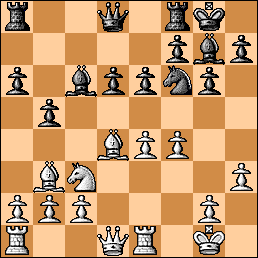
Black is all right
15. a3 Qd7! A nice idea in the Sozin, preparing the next move with good counterplay.
16. Qe2 Qb7 17. Rad1 a5 18. e5 Of course not a move white wants to play. The absence of the light square bishop on the kingside will prove to be a serious problem for white.
18…Nh5 19. Qf2 dxe5 20. Bxe5 Rfd8 21. Qh4?
A blunder.
21…Qb6+? (The computer points out 21… Rxd1 22. Rxd1 Bxe5 23. fxe5 a4 24. Ba2 Bxg2 and black wins)
22. Kh2 Bxe5 23. Rxe5 Rxd1 24. Nxd1 Qd4 (24… Rd8 25. Ne3 Rd2 26. Qg5 Qd4) 25. Ne3 Qxf4+ (25… Nxf4
26. Ng4 Qd2 wins also)
26. Qxf4 Nxf4 27. g3 Nd5 (Stronger is 27… Ne2! 28. Rc5 a4 29. Ba2 Kg7!)
28.Nxd5 Bxd5 29. Bxd5 exd5 30. c3 Rd8 31. Kg2 Kg7 32. Kf3 Kf6 33. Re2 h5 34. Rd2
Ke5 35. Rd4 Rc8 36. h4 Rc4 37. Rd2 Re4 38. Rd3 a4 39. Rd2 f6 40. Rd3 g5 41.
hxg5 fxg5 42. Rd2 g4+!
Now black grinds out a long endgame where his vast superiority in space finally results in a win.
43. Kf2 Kd6 44. Rd1 Kc5 45. Rh1 Re5 46. Rd1 Rf5+ 47. Kg2 Rf3 48. Rd2 Re3 49. Kf2 Re4 50. Rd1 Kc4 51. Rd2 d4 52. cxd4 Rxd4 53. Re2 Kb3 54. Ke3 Rd1 55. Rh2 Rb1 56. Rxh5 Rxb2 57. Rxb5+ Kxa3 58. Rg5 Rb3+ 59. Kd2 Kb2
0-1
Tisdall took revenge a year later, beating me as black in short order in a RATED game in the 1980 GHI International in New York City.
Well, in this event, Princeton wins by half a point, whew! This game was almost certainly the last one to conclude in the 8 game match. I must admit it was strange to have only 3 teams (one team having a bye each round); I can only guess that perhaps there was a fourth invited team that could not attend. Maybe Kenny Regan remembers??
Chess U Banner Ad test (click on me)

